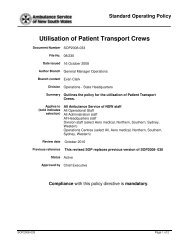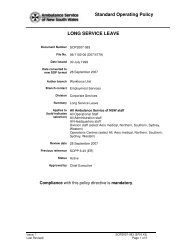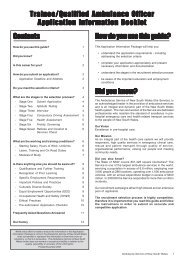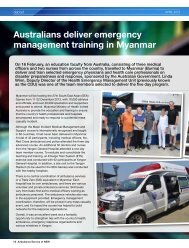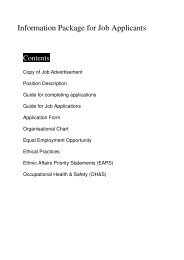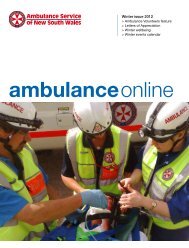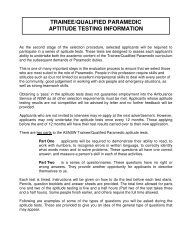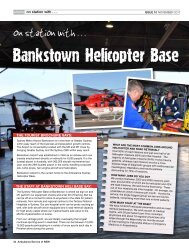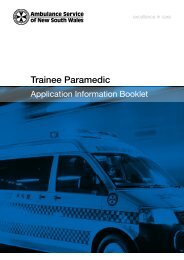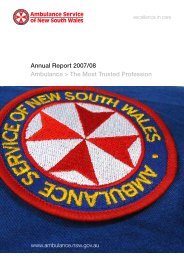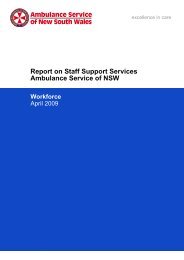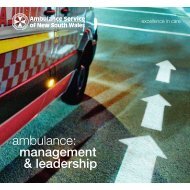atsb final report released 16 may 2013 - Ambulance Service of NSW
atsb final report released 16 may 2013 - Ambulance Service of NSW
atsb final report released 16 may 2013 - Ambulance Service of NSW
Create successful ePaper yourself
Turn your PDF publications into a flip-book with our unique Google optimized e-Paper software.
TERMINOLOGY USED IN THIS REPORTOccurrence: accident or incident.Safety factor: an event or condition that increases safety risk. In other words, it issomething that, if it occurred in the future, would increase the likelihood <strong>of</strong> anoccurrence, and/or the severity <strong>of</strong> the adverse consequences associated with anoccurrence. Safety factors include the occurrence events (e.g. engine failure, signalpassed at danger, grounding), individual actions (e.g. errors and violations), localconditions, current risk controls and organisational influences.Contributing safety factor: a safety factor that, had it not occurred or existed at thetime <strong>of</strong> an occurrence, then either: (a) the occurrence would probably not have occurred;or (b) the adverse consequences associated with the occurrence would probably not haveoccurred or have been as serious, or (c) another contributing safety factor wouldprobably not have occurred or existed.Other safety factor: a safety factor identified during an occurrence investigation whichdid not meet the definition <strong>of</strong> contributing safety factor but was still considered to beimportant to communicate in an investigation <strong>report</strong> in the interests <strong>of</strong> improvedtransport safety.Other key finding: any finding, other than that associated with safety factors,considered important to include in an investigation <strong>report</strong>. Such findings <strong>may</strong> resolveambiguity or controversy, describe possible scenarios or safety factors when firm safetyfactor findings were not able to be made, or note events or conditions which ‘saved theday’ or played an important role in reducing the risk associated with an occurrence.Safety issue: a safety factor that (a) can reasonably be regarded as having the potential toadversely affect the safety <strong>of</strong> future operations, and (b) is a characteristic <strong>of</strong> an organisation ora system, rather than a characteristic <strong>of</strong> a specific individual, or characteristic <strong>of</strong> an operationalenvironment at a specific point in time.Risk level: the ATSB’s assessment <strong>of</strong> the risk level associated with a safety issue is noted inthe Findings section <strong>of</strong> the investigation <strong>report</strong>. It reflects the risk level as it existed at the time<strong>of</strong> the occurrence. That risk level <strong>may</strong> subsequently have been reduced as a result <strong>of</strong> safetyactions taken by individuals or organisations during the course <strong>of</strong> an investigation.Safety issues are broadly classified in terms <strong>of</strong> their level <strong>of</strong> risk as follows:• Critical safety issue: associated with an intolerable level <strong>of</strong> risk and generallyleading to the immediate issue <strong>of</strong> a safety recommendation unless correctivesafety action has already been taken.• Significant safety issue: associated with a risk level regarded as acceptable only ifit is kept as low as reasonably practicable. The ATSB <strong>may</strong> issue a safetyrecommendation or a safety advisory notice if it assesses that further safety action<strong>may</strong> be practicable.• Minor safety issue: associated with a broadly acceptable level <strong>of</strong> risk, althoughthe ATSB <strong>may</strong> sometimes issue a safety advisory notice.Safety action: the steps taken or proposed to be taken by a person, organisation or agency inresponse to a safety issue.- viii -



